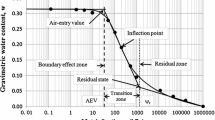Abstract
We examine the outcome of popular artificial neural network (ANN) and adaptive neuro-fuzzy inference system (ANFIS) for estimating the shear strength parameters of c − φ soil. A matrix of one hundred twelve datasets collected using in situ and laboratory tests to train and test the ANN and ANFIS models. Standard penetration test number of blows value along with the soil properties taken as input vectors, whereas shear strength parameters like cohesion (c) and angle of internal friction (ϕ) used as target vectors. The minimum validation error has been employed as the stopping criterion to avoid over fitting in the analysis. Out of four developed models, predicted values through two ANN models were close to actual value in comparison to ANFIS models. Statistical parameters such as coefficient of correlation, root mean square error and average absolute error were used as performance evaluation measures. Based on statistical measures it was observed that performances of ANN and ANFIS models were in accordance with the experimental results and it could substitute tedious laboratory work provided sufficient and reliable data source are offered. The results through performance evaluation measures also reveal that ANN and ANFIS models are effective, versatile and useful way to measure the shear strength parameters of soils.







Similar content being viewed by others
References
Al-Shayea NA (2001) The combined effect of clay and moisture content on the behavior of remolded unsaturated soils. J Eng Geol 62(4):319–342
Cokca E, Erol O, Armangil F (2004) Effects of compaction moisture content on the shear strength of an unsaturated clay. J Geotech Geol Eng 22(2):285–297
Hettiarachchi H, Brown T (2009) Use of SPT blow counts to estimate shear strength properties of soils: energy balance approach. J Geot Geoenviron Eng 135(6):830–834
Takagi T, Sugeno M (1985) Fuzzy identification of systems and its application to modelling and control. IEEE Trans Syst Man Cybern 15(l):116–132
Goh ATC, Kulhawy FH (2003) Neural network approach to model the limit state surface for reliability analysis. Can Geotech J 40(6):1235–1244
Wan S, Yen JY (2006) The study of SSI problems in an industrial area with modified neural network approaches. Int J Numer Anal Meth Geomech 32(9):1087–1106
Shangguan Z, Li S, Luan M (2009) Intelligent forecasting method for slope stability estimation by using probabilistic neural network. Electr J Geotech Eng 13:1–10
Zhang G, Xiang X, Tang H (2011) Time series prediction of chimney foundation settlement by neural networks. Int J Geomech 11(3):154–158
Alipour A, Jafari A, Hossaini SMF (2012) Application of ANNs and MVLRA for estimation of specific charge in small tunnel. Int J Geomech 12(2):189–192
Venkatesh K, Kumar V, Tiwari RP (2013) Appraisal of liquefaction potential using neural network and neuro fuzzy. Appl Artif Intell Int J 27(8):700–720
Kumar V, Venkatesh K, Tiwari RP (2014) A neurofuzzy technique to predict seismic liquefaction potential of soils. Int J Neural Netw World 24:249–265
Ranasinghe RATM, Jaksa MB, Kuo YL, Nejad FP (2017) Application of artificial neural networks for predicting the impact of rolling dynamic compaction using dynamic cone penetrometer test results. J Rock Mech Geotech Eng 9(2):340–349
Acharyya R, Dey A, Kumar B (2018) Finite element and ANN-based prediction of bearing capacity of square footing resting on the crest of c-φ soil slope. Int J Geotech Eng 12(2):1–12
Akbulut S, Kalkan E, Celic S (2003) Artificial neural networks to estimate the shear strength of compacted soil samples. In: Proceedings of international conference on new developments in soil mechanics and geotechnical engineering, 29–31 May, Turkish National Committee of Soil Mechanics and Geotechnical Engineering; Near East University, Nicosia, TRNC, pp 285–290
Kalkan E, Akbulut S, Tortum A, Celik S (2008) Prediction of the unconfined compressive strength of compacted granular soil by using inference system. J Environ Geol 58(7):1429–1440
Kaya A (2009) Residual & fully softened strength evaluation of soils using artificial neural network. J Geotech Geol Eng 27(2):281–288
Kayadelen C (2008) Estimation of effective stress parameter of unsaturated soils by using artificial neural networks. Int J Numer Anal Meth Geomech 32(9):1087–1106
Kayadelen C, Gunaydın O, Fener M, Demir A, Ozvan A (2009) Modeling of the angle of shearing resistance of soils using soft computing systems. J Exp Syst Appl 36(9):11814–11826
Altun S, Goktepe AB, Ansal AM, Akguner C (2009) Simulation of torsional shear test results with neuro-fuzzy control system. J Soil Dyn Earthq Eng 29(2):253–260
Zaman M, Solanki P, Ebrahimi A, White L (2010) Neural network modeling of resilient modulus using routine subgrade soil properties. Int J Geomech 10(1):1–12
Samui P, Sitharam TG (2010) Site characterization model using artificial neural network and kriging. Int J Geomech 10(5):171–180
Rafiq MY, Bugmann G, Easterbrook DJ (2001) Neural network design for engineering applications. J Comput Struct 79(17):1541–1552
Gunaydım O (2009) Estimation of soil compaction parameters by using statistical analyses and artificial neural networks. J Environ Geol 57(1):203–215
Author information
Authors and Affiliations
Corresponding author
Ethics declarations
Conflict of interest
The authors declare that we have no conflict of interest.
Additional information
Publisher's Note
Springer Nature remains neutral with regard to jurisdictional claims in published maps and institutional affiliations.
Rights and permissions
About this article
Cite this article
Venkatesh, K., Bind, Y.K. ANN and Neuro-Fuzzy Modeling for Shear Strength Characterization of Soils. Proc. Natl. Acad. Sci., India, Sect. A Phys. Sci. 92, 243–249 (2022). https://doi.org/10.1007/s40010-020-00709-6
Received:
Revised:
Accepted:
Published:
Issue Date:
DOI: https://doi.org/10.1007/s40010-020-00709-6




